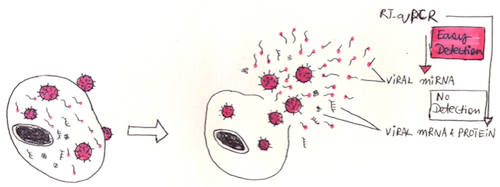07.05.17 last updated.
07.05.17 last updated.
Early detection of viral infections is extremely important for control of disease transmission, prompt initiation of treatment, and prevention of infection-related complications. Because of our hypothesis that viral DNA, messenger RNA, and proteins cannot be detected in all infected individuals, we wanted to determine whether detection of exogenous miRNAs encoded by viruses represents a more sensitive assay of the true prevalence of infection by viruses including latent Kaposi Sarcoma Herpes Virus (KSHV) and Epstein Barr Virus (EBV). Therefore, we measured plasma miRNAs using RT-qPCR and compared it to the current standard method for detection of viral infection, an enzyme-linked immunosorbent assay (ELISA) of blood plasma, which detects antibodies generated by the host against the infecting virus. Our study population was 214 Caucasian patients from the United States and Romania, separated into four independent patient cohorts. We examined a total of 300 plasma samples from this population. This study enabled us to develop an approach to detect infection by KSHV using multiplexed RT-qPCR of multiple viral miRNAs.
We found that our method had clear advantages over the current ELISA-based approach. It detected a significantly higher prevalence of KSHV infection than that determined by seropositivity, with the difference most pronounced in immuno-depressed patients. When applied to EBV, our new method based on plasma viral miRNA quantification proved that EBV infection is ubiquitous. This strategy has the potential to become a gold standard method in clinical practice to detect latency of viruses and viremia — viral infection of the bloodstream — in both general and immune-compromised populations.

Detecting viral infection by amplifying viral miRNA has clear advantages over the current ELISA-based approach.
Fuentes-Mattei E, Giza DE, Shimizu M, Ivan C, Manning JT, Tudor S, Ciccone M, Kargin OA, Zhang X, Mur P, do Amaral NS, Chen M, Tarrand JJ, Lupu F, Ferrajoli A, Keating MJ, Vasilescu C, Yeung SJ, Calin GA. Plasma viral miRNAs indicate a high prevalence of occult viral infections. EBioMedicine. (2017) 20:182-192. doi: 10.1016/j.ebiom.2017.04.018. Pubmed: 28465156.
There are no comments.